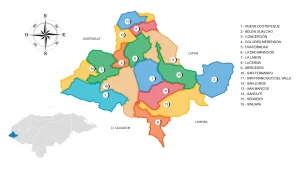Municipality of Ojos de Agua
Ojos de Agua is a municipality in the department of Comayagua in Honduras.
The municipality of Ojos de Agua is one of the most rugged or topographically broken; hills and mountains predominate throughout its extension.
The most important mountain that crosses the municipality is located in the Northeast sector, exclusively dedicated to coffee cultivation. This mountain range is part of the Comayagua mountain range, ending in the plateau known as Valle Grande.
As it passes through the municipality of Ojos de Agua, it receives different names, with ‘Montaña del Indio’ being the most renowned, reaching its highest point at 1,485 meters above sea level.
Its name originates from the existence of many wells or streams with abundant water, with some of them still preserved today. It is believed that the first settlers were originally from the Meambar District, now a municipality, and the town of Carrizal Grande, now the village of San Rafael.
There is no exact data on when the first inhabitants arrived at what is now the municipal seat, but it is known for certain that they arrived long before the Independence of Central America, according to the book «Municipios de Honduras» (Municipalities of Honduras).
Location
- North: Municipality of Las Lajas
- South: Municipalities of La Trinidad
- East: Municipality of La Libertad
- West: Municipality of Meambar
Villages
- Campo Dos
- Los Guineos
- Buenos Aires 1
- Buenos Aires 2
- Candelaria
- El Naranjal
- Pinabetoso
- Agua Blanca
- El Hielo
- El Robledal
- Los Dos Ríos
- El Jagual 1
- El Portillo Grande
- Nueva Esperanza
- El Jagual 2
- Corralitos
- San Rafael
- Los Anices
- La Unión
- La Florida
- La Masica
- San Antonio
- San Francisco
Hamlets
- Monte Redondo
- La Pajuina
- La Palma
- Los Naranjos
- La Cañada
- Plan del Cerro
- La Aguja
Flora
The municipality of Ojos de Agua fell victim to the plunder carried out by logging campaigns, which were directly responsible for the destruction of our flora, in collusion with the governments of the time and local authorities.
Among the groups of plants currently preserved in the municipality, we have pine, oak, nance, liquidambar, light avocado, aceituno, ascan, almendro, maria, cedar, mahogany, guanacaste, ceiba, madreado, mando, orange, tamarind, pendula, chichipale, capulin, marafunda, arrayan, guama, guajiquil, white thorn, cachito, jagua, guayabo, jicaro, cilinera, quebracho, pipa avocado, chaparro, curtidor, white oak, jiñicuite, sangroso, fig, muddy, laurel, jucucua, palo brujo, olive, lemon, annatto, etc.
There are also numerous plants used in natural medicine, such as zacate té, valerian, chirivito, alcotana, flower of October, guaco root, perula, zarzaparrilla, siempre viva, old man’s flower, scorpion tail, sauco, cabeza de negrito, sangre de grago, etc. There are also plants used in the handicraft industry, such as vallal, mezcal, izote, etc.
In addition, ornamental plants have been incorporated, such as eucalyptus, yellow acacia, laurel, ficus, African palm, carreto, neem, cypress, etc. Most of these plants are found in highly representative groups in different areas of the municipality.
Fauna
- White-tailed Deer
- Armadillo
- Tamagaz Snake
- Coral Snake
- Real Coral Snake
- Rattlesnake



